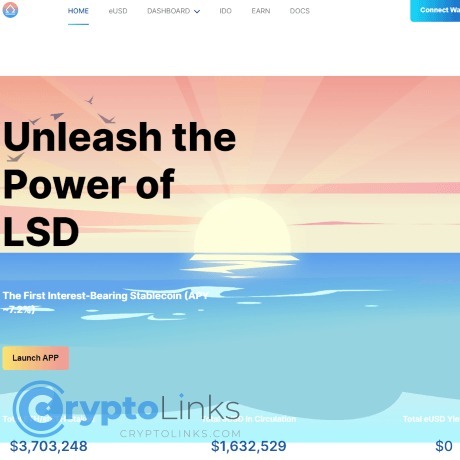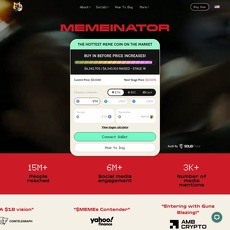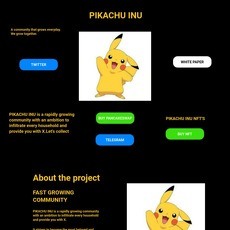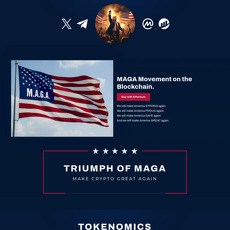Lybra DAO Review
Lybra DAO
lybra.finance
If your website is on the scam list and you think that you are not a scammer, contact us. After you provide us with all the proof that you are in Crypto World with good intentions, we will delist you. Usually, you get in this category because you are hiding your team, you have a bad reputation(you are tricking, deceiving, scamming people), and you haven't got a written project whitepaper or is a shitty one....
Their Official site text:
Stablecoins on the Market
At present, stablecoins in the cryptocurrency domain can be categorized into three types: Fiat-Collateralized stablecoins, Cryptocurrency-Collateralized stablecoins, and Algorithmic stablecoins. The distinctions among them are based on the nature of the underlying assets, collateral ratios, stablecoin issuance methods, and price stability mechanisms.
1. Fiat-Collateralized stablecoins
Fiat-Collateralized stablecoins are stablecoins issued with fiat currencies (such as USD, EUR, etc.) as collateral, such as Tether (USDT), USD Coin (USDC), and TrueUSD (TUSD). These stablecoins are usually issued and managed by centralized institutions, and maintain a collateral ratio of 1:1 in general, which means that for every stablecoin issued, one unit of legal currency needs to be pledged as collateral.
2. Cryptocurrency-collateralized stablecoins
Cryptocurrency-Collateralized stablecoins are stablecoins issued with cryptocurrencies (such as Bitcoin, Ethereum, etc.) as collateral, such as Dai, BitUSD, and sUSD. The collateral ratio of these stablecoins is relatively low, usually 1:1.5 or 1:2, which means that to issue every one of a stablecoin, 1.5 or 2 cryptocurrencies need to be pledged as collateral.
3. Algorithmic stablecoins
Algorithmic stablecoins are stablecoins that use algorithms to maintain stablecoin prices, such as Basis Cash and Frax. The price maintenance mechanism of these stablecoins is relatively complex, usually introducing elastic supply mechanisms and incentive mechanisms to adjust supply and demand and maintain price stability.
Interest-Bearing Stablecoin
Stablecoins generally differ in terms of the assets backing them, collateral ratios, issuance mechanisms, and price maintenance mechanisms. While various stablecoins may be suitable for different application scenarios, they all share one common shortcoming: the lack of interest income.
Does this imply that stablecoin holders do not require interest income? Certainly not.
However, since stablecoins do not generate interest, their holders have no choice but to bear the continuous depreciation of the USD due to the Federal Reserve's high interest rates caused by inflation.
If stablecoin holders indeed require interest income, why not simply offer it? The reason is that current stablecoins are incapable of doing so due to their issuance mechanisms and underlying assets.
Most fiat-collateralized stablecoins are issued by centralized or decentralized organizations. Although these stablecoins usually maintain a stable value and a high collateral ratio, their total issuance tends to be relatively small. Consequently, this leads to lower yields and makes it challenging to provide high returns comparable to bank deposits.
Cryptocurrency-Collateralized stablecoins are typically issued when holders pledge a certain amount of cryptocurrency as collateral. Since the collateralized cryptocurrencies cannot generate interest income, stablecoin issuers are unable to provide a secure and stable income to their holders.
In conclusion, the current absence of interest in stablecoins primarily stems from their issuance mechanisms and underlying assets. This whitepaper will explore an interest-bearing stablecoin collateralized by ETH and stETH, addressing the need for stablecoin holders to generate interest income while maintaining the key features of stablecoins.
Following the Ethereum Shanghai upgrade, decentralized interest-generating stablecoins will at last have a viable solution. Decentralized smart contracts leveraging the high yields provided by the Liquid Staking Derivatives (LSD) revenue flywheel will generate secure, price-stable, and interest-stable stablecoins, such as eUSD.
The introduction of eUSD as an interest-bearing stablecoin collateralized by ETH and stETH will offer stablecoin holders the opportunity to earn interest income while preserving the key attributes of stablecoins. This innovation will bridge the gap between traditional stablecoins and the need for interest generation, creating a more attractive and functional stablecoin alternative.
Our Mission
Our primary objective is to establish eUSD as an interest-bearing, secure, and fully decentralized stablecoin that functions as a genuine crypto bank account for its holders, independent of any government or authority.
We aim to deliver innovative and all-encompassing solutions for Ethereum-based assets, enhancing user flexibility and control over liquidity management.
Committed to fostering the expansion of the Ethereum staking ecosystem, we facilitate the participation of ETH asset holders of all scales, ensuring minimal barriers to entry.
We endeavor to provide state-of-the-art, easily integratable components that harmonize with existing protocols.
Our methodology encompasses transparent yield reporting and inventive emission approaches, establishing a sustainable token economy that fosters a positive feedback loop for Ethereum asset returns.
By amalgamating LSD yields and generating superior returns through a robust DeFi mechanism, we strive to emerge as the leading ETH staking yield protocol, ultimately promoting the accumulation of ETH and diversified LSD assets.
Introduction to the Lybra Protocol
The Lybra Protocol is a groundbreaking decentralized protocol designed to bring stability to the volatile world of cryptocurrency. Built on LSD (Liquid Staking Derivatives), the protocol initially leverages Lido Finance-issued ETH proof-of-stake and stETH as its primary components, with plans to support additional LSD assets in the future.
The protocol's primary objective is to provide the cryptocurrency industry with a safer, more decentralized stablecoin, eUSD, which offers stable interest to its token holders.
As a DeFi protocol, Lybra facilitates the minting of eUSD by allowing users to borrow against their deposited ETH and stETH.
eUSD, being an ETH-assets-over-collateralized stablecoin, offers users the security and stability necessary for conducting their business with confidence.
A distinctive feature of the Lybra Protocol is that users can earn regular stable income by holding minted (borrowed) eUSD, which is powered by the LSD (Liquid Staking Derivatives) income generated from the deposited ETH and stETH. In other words, when users deposit ETH or stETH and mint EUSD against them, they receive a stable income in stETH of approximately 5%, which is converted to eUSD through the protocol and distributed to them.
eUSD is an interest-bearing, over-collateralized stablecoin that ensures safety and stability. The Lybra Foundation and LybraDAO community firmly believe that a decentralized stablecoin is essential for both enterprises and individuals to fully harness the benefits of cryptocurrency. By offering an interest-bearing stablecoin supported by ETH and stETH, the Lybra Protocol empowers users to participate in the DeFi ecosystem with confidence and security.
What is eUSD?
eUSD is a stablecoin pegged to the US Dollar, backed by an excess of ETH collateral, and issued in a decentralized and unbiased manner. Simply holding eUSD generates a stable income with an APY of approximately 8%.
Thanks to its low volatility and stable interest income, eUSD can counteract harmful inflation and provide economic freedom and opportunities for individuals worldwide.
By depositing ETH into the Lybra Protocol, the deposited ETH can be used as collateral to mint/borrow eUSD at a healthy mint ratio for use in DeFi at any time.
How does eUSD generate interest?
Deposited ETH is automatically converted to stETH through the Lybra Protocol. (stETH is an ERC20 token representing ETH staked with Lido) One stETH can always be exchanged for one ETH, and due to the LSD (Liquidity Staking Derivatives) process, stETH will continue to grow over time Increased income from stETH is converted to eUSD based on the USD value of ETH at that time A certain percentage of the increased income is shared proportionally among stLBR holders The remaining income is distributed to eUSD holders, with a base APY of approximately 8%
For Example,
Alice deposits $135,000,000 ETH and mints 80,000,000 eUSD
Bob deposits $15,000,000 ETH and mints 7,500,000 eUSD
Current eUSD circulation = 80,000,000 + 7,500,000 = 87,500,000
Current collateral = $135,000,000 + $15,000,000 = $150,000,000 stETH
1 year later,
LSD income = $150,000,000 * 5% = ~$7,500,000 stETH
Bob uses his holding 7,500,000 eUSD to buy the increased stETH
Service Fee during the past 1 year = eUSD circulation (i.e. 87,500,000) * 1.5% = 1,312,500 eUSD
Dividends 7,500,000 eUSD - 1,312,500 eUSD =6,187,500 eUSD is distributed among all eUSD holders (aka. Alice)
Current situation:
Alice's collateral = $135,000,000 ETH, debt = 80,000,000 eUSD, holding 80,000,000 + 6,187,500 = 86,187,500 eUSD
eUSD APY =6,187,500 / 80,000,000 = ~7.734%
Bob's collateral = $15,000,000 ETH, debt = 7,500,000 eUSD, holding 0 eUSD, and holding $7,500,000 ETH
Current eUSD circulation still = 87,500,000
Current collateral still = $135,000,000 + $15,000,000 = $150,000,000 ETH
Why should I hold eUSD?
Every crypto user needs to maintain stable currencies in their portfolio. Unfortunately, most stablecoins do not offer reliable revenue. Does this mean that holders of stablecoins don't require interest income? Absolutely not.
All USDC/USDT/DAI users are welcome to exchange their stablecoins for eUSD, utilize eUSD for various DeFi activities, and benefit from the stable interest rate for additional income. Moreover, eUSD features a 0% loan interest, allowing users to go leveraged long on ETH with zero loan cost. By holding eUSD, users can enjoy the stability of a traditional stablecoin while also earning interest and taking advantage of cost-free leverage, making it an attractive option for those looking to optimize their DeFi portfolio's performance.
What Properties of eUSD Function Similarly to Money?
Money generally has four functions:
A store of value
A medium of exchange
A unit of account
A standard of deferred payment
eUSD has properties and use cases designed to serve these functions.
eUSD as a Store of Value
A store of value is an asset that retains its value over time. Since eUSD is a stablecoin, it is designed to maintain its value even in volatile markets.
eUSD as a Medium of Exchange
A medium of exchange is anything that represents a standard of value and facilitates the trade of goods or services. As a stablecoin, eUSD can be used worldwide for transactions.
eUSD as a Unit of Account
A unit of account is a standardized measurement of value used to price goods and services (e.g., USD, EUR, YEN). eUSD currently has a target price of 1 USD (1 eUSD = 1 USD). While eUSD is not used as a standard measurement of value outside of the Lybra Protocol, it functions as a unit of account within the protocol and within some other blockchain dApps, where the accounting or pricing of dApp services is in eUSD rather than a fiat currency like USD.
eUSD as a Standard of Deferred Payment
eUSD is used to settle debts within the Lybra Protocol (e.g., users utilize eUSD to repay loans and redeem their collateral assets).
eUSD as an Interest-Bearing Asset
eUSD holders can receive regular stable interest income on a daily/weekly basis, or they can stake eUSD to provide eUSD/ETH liquidity and earn staking rewards. By offering interest income, eUSD serves as an attractive option for users looking for stable value and potential returns on their holdings.
How can eUSD stability be ensured?
eUSD stability is maintained through a combination of overcollateralization, liquidation mechanisms, and arbitrage opportunities. These factors work together to ensure that the value of eUSD remains close to its 1 USD peg.
1. Overcollateralization
Each 1 eUSD is backed by at least $1.5 worth of stETH as collateral. Overcollateralization helps maintain stability by ensuring that the value of the underlying collateral is greater than the value of the eUSD issued. This buffer reduces the risk of insolvency and provides a level of security for eUSD holders.
2. Liquidation Mechanisms
The Lybra Protocol incorporates liquidation mechanisms to protect the system from undercollateralized positions. If a user's collateral rate falls below the safe Collateral Rate, any user can volunteer to be a Liquidator and buy the liquidated portion of collateralized stETH, paying in corresponding eUSD (100% - Liquidation Reward Rate). This mechanism ensures appreciation pressure on eUSD and helps maintain stability.
3. Arbitrage Opportunities
Arbitrage opportunities arise when the eUSD price deviates from its 1 USD peg. Users can take advantage of these price discrepancies to make a profit and help restore the eUSD price to its intended value.
eUSD price above 1 USD: If the eUSD price exceeds 1 USD, users can mint new eUSD by depositing ETH as collateral and then sell the newly minted eUSD on DEX. As more eUSD is sold, the market supply increases, pushing the price back down to 1 USD. Users can then buy back eUSD at a lower price or use it to repay their loans, realizing a profit from the price difference.
eUSD price below 1 USD: If the eUSD price falls below 1 USD, users can purchase eUSD at a discounted rate on the market and then redeem it within the Lybra Protocol for $1 worth of ETH/stETH. As users buy up the undervalued eUSD, demand increases, driving the price back up to 1 USD. Users can either hold the redeemed ETH/stETH or sell it, profiting from the price difference.
In both scenarios, users engaging in arbitrage help to maintain the stability of eUSD by correcting price imbalances and restoring the eUSD price to its 1 USD peg.
What is LBR?
LBR is the native token of the Lybra Protocol.
The Lybra Protocol is managed by people worldwide who hold its native governance token, LBR. stLBR holders participate in governance and voting while sharing the protocol's revenue.
You can obtain LBR tokens by participating in the Lybra LBR IDO, earning rewards through minting eUSD, or becoming an eUSD/ETH Liquidity Provider.
Where does Lybra Protocol's revenue come from?
Minting and redeeming/repaying eUSD is free of charge.
Lybra Protocol charges an annual service fee of 1.5% on the total amount of eUSD in circulation. (The service fee accrues every second based on the current actual eUSD circulation.)
After deducting the service fee, the stETH income generated by LSD that Lybra Protocol receives is distributed among eUSD holders.
LBR Holders' Real-Yield
The service fee collected by the Lybra Protocol is allocated to the LBR Staking Pool.
For example, if the total circulation of eUSD is 1 billion, the service fee collected in a year would amount to 15,000,000 eUSD. If you hold 1% of stLBR in the LBR Staking Pool, you will receive 150,000 eUSD as your Real-Yield for that year.
Introduction
The Lybra Protocol is a DeFi system that allows you to deposit ETH and mint the stablecoin eUSD without any fees or borrowing interest. eUSD held in your account will receive a stable interest rate.
In the Lybra Protocol, users can take on the roles of Minters, Holders, Liquidators, Redemption Providers, Keepers, and/or others.
Minting
Why would I use Lybra for minting (borrowing)?
Lybra Protocol offers negative-interest loans. The protocol enables you to borrow eUSD using your ETH as collateral, earn a steady income, and repay your debt later. This eliminates the need to trade your ETH to access liquid funds while your held eUSD also earns a stable interest rate over time.
What are the Minting Requirements?
The user's collateral rate should be above the safe collateral rate, which is 160%.
When a user's mint amount is > 1,000,000 eUSD, the total mint amount should not exceed 10% of all eUSD in circulation.
What is collateral?
Collateral is any asset that a borrower must provide to take out a loan, acting as security for the debt. Currently, Lybra only supports ETH and stETH as collateral.
Lybra Protocol automatically converts any ETH deposits to stETH. The protocol treats 1 ETH as 1 stETH, so all references to stETH below are to ETH.
What's the logic behind 0-interest loans?
There are no borrowing (minting) costs or interest charges in the Lybra Protocol. However, the protocol exchanges the LSD (Liquidity Staking Derivatives) revenue generated by stETH into eUSD and airdrops it proportionally to eUSD holders, allowing users to make more the longer they borrow (mint/hold).
stETH LSD APY is ~5%, of which, 1.5% will be distributed to stLBR holders (which can be revised by the Lybra Community DAO).
What is the timeline for repayment?
There is no set payback period for loans issued by Lybra Protocol. As long as you maintain a collateral ratio of at least 150%, you are allowed to keep the loan open and pay off your debt whenever you want.
What is the Collateral Rate?
The collateral rate is the ratio between the dollar value of your collateral in the Lybra Protocol Vault and your loans in eUSD. The collateral rate fluctuates over time as the price of ETH changes. You can influence the rate by adjusting your collateral and/or debt — i.e., adding more ETH collateral or paying off some of your debt.
For Example,
Let's say the current price of ETH is $2,000 when you deposit 10 ETH. If you mint (borrow) 10,000 eUSD, then your current collateral rate is 200%.
What is the minimum collateral rate (MCR) and the "recommended" collateral ratio?
The minimum collateral rate (or MCR) is the lowest ratio of loan to collateral that will not trigger a liquidation under normal operations (AKA Normal Mode). This parameter is set to 150% on Lybra Protocol.
i.e., if you have a loan of 10,000 eUSD, you would need at least $15,000 worth of ETH as collateral to avoid the risk of being liquidated.
To keep your funds safe and avoid getting liquidated, it's highly recommended you maintain a collateral rate higher than 200%.
Rigid Redemption and eUSD Price Stability
How is eUSD hard-pegged to the price of USD?
eUSD maintains a hard peg to the price of USD through a combination of direct and indirect mechanisms. Directly, the ability to redeem eUSD for ETH at face value (1 eUSD for $1 of ETH) and the minimum collateral ratio of 150% create a price floor and ceiling, respectively, through arbitrage opportunities. These are called "hard peg mechanisms".
eUSD also benefits from indirect mechanisms for USD parity, referred to as "soft peg mechanisms". One such mechanism is parity as a Schelling point. Since Lybra treats eUSD as equal to USD, parity between the two is an implied equilibrium state of the protocol.
Users can take advantage of arbitrage opportunities by exchanging $1 worth of ETH for $1 eUSD when eUSD falls below $1 (eUSD is equal to $1 USD at face value).
What is Rigid Redemption?
Rigid redemption is the process of exchanging eUSD for ETH at face value, as if 1 eUSD is exactly worth $1. In other words, for x eUSD, you get x dollars worth of ETH in return.
Users can redeem their eUSD for ETH at any time without limitations. However, a 0.5% rigid redemption fee (subject to revision by the Lybra Community DAO) is charged on the redeemed amount, and this fee is fully paid to the redemption provider.
For Example,
If the current redemption fee is 0.5%, the price of ETH is $1,500, and you redeem 1,200 eUSD, you would receive 0.796 ETH (0.8 ETH minus a redemption fee of 0.004 ETH).
Please note that the redeemed amount is considered when calculating the base rate and may impact the redemption fee, especially for large amounts.
Is rigid redemption the same as paying back my debt?
No, rigid redemption and paying back debt are two entirely separate mechanisms. Rigid redemption involves exchanging eUSD for ETH at face value, while paying back debt is the adjustment of collateral and debt.
How is the rigid redemption fee calculated?
Under normal operation, the Rigid Redemption Fee = 0.5% * Redeemed ETH.
If the rigid redemption is conducted through passively generated stETH, the redemption fee is 0.
How does the rigid redemption mechanism work?
The passively increased stETH in the Lybra Protocol can be used for rigid redemption at any time. (i.e., passively increased stETH = stETH balance - Total deposited ETH)
Lybra Protocol offers a rigid redemption service feature. If a user chooses to provide rigid redemption services, they will be incentivized through token airdrops, service fee compensations, and other means.
Redemption Provider
As a (minter) borrower, you can choose whether to provide rigid redemption services. You will only participate in rigid redemptions if you opt to become a redemption provider.
During the redemption process, you will lose a portion of your collateral, but your debt will be reduced accordingly. After becoming a redemption provider, you must provide the service for a minimum of 7 days before it can be canceled.
The USD value reduction of your ETH collateral corresponds to the nominal eUSD amount decrease in your debt. You can think of redemptions as if someone else is repaying your debt and retrieving an equivalent amount of your collateral. As a positive side effect, redemptions improve the collateral rateof the affected collateral and debt, making them less risky. Redemptions that do not reduce your debt to 0 are called partial redemptions, while redemptions that fully pay off the debt are called full redemptions.
For example,
A user deposits 3 ETH ($4,500) as collateral and mints (borrows) 3,000 eUSD. This puts their collateral rate at 100% * 4500 / 3000 = 150%. Let's imagine this is the lowest collateral rate and look at two examples of partial and full redemptions:
Example of a partial redemption
Someone redeems your ETH using 1,500 eUSD, and the redemption fee is 0.5%. The redemption provider gets 0.995 ETH in return (=1500 * 99.5% / 1500), and your collateral is reduced from 3 ETH to 2.005 ETH. Your debt is now 1,500 eUSD, raising your collateral rate from 150% to 100% * 2.005 * 1500 / 1500 = 200.5%.
Example of a full redemption
Someone redeems your 3 ETH using 4,500 eUSD. Given that the redemption amount exceeds your debt, your debt of 3,000 eUSD will be fully liquidated, and the collateral will be reduced by 3,000 * 0.995 worth of ETH, leaving you with 1.01 ETH of collateral (= 3 - 3,000 * 0.995 / 1,500).
What are the advantages of being a Redemption Provider?
You can charge a 0.5% fee whenever someone redeems their eUSD against your ETH collateral.
You won't experience a total loss even if your collateral is redeemed. Only a part of your ETH position will be lost, and your eUSD debt will be reduced accordingly. Additionally, your collateral rate will increase to a much healthier level following the redemption.
The yield of the LBR reward as a redemption provider is increased by 50%.
How can I avoid being rigidly redeemed against?
You'll only be subjected to rigid redemption once you choose to provide redemption services.
Liquidation
What is Liquidation?
Borrowers (minters) whose collateral rate falls below 150% of the minimum collateral rate must be liquidated to ensure that the eUSD stablecoin is fully backed by collateral assets.
During liquidation, the borrower's (minter's) debt is reduced, and liquidators receive the collateral asset in exchange for paying off the debt.
After liquidation, the borrower's (minter's) reduced debt is paid off, and the value of the remaining collateral equals 110% of the reduced debt.
It is highly recommended to always maintain a healthy collateral rate above 150%, preferably above 200%.
Liquidators
Liquidators are the first line of defense in preserving system viability. By becoming a liquidator, users can use their eUSD to settle any borrowers' (minters') debts at any time, maintaining the stability of eUSD and the total supply of eUSD. Liquidators are rewarded when liquidation proceeds.
When a borrower (minter) is being liquidated, eUSD corresponding to up to 50% of the borrower's remaining debt is burned from the liquidator's balance to settle the debt. In return, the liquidator receives the collateral asset worth 109% of the value of the repaid eUSD, and at least 0.5% of the collateral asset goes to the Keeper.
Keepers
Any third party can operate a Keeper Program to monitor the state of each liquidator and borrower (minter) on the Lybra Protocol.
When a borrower needs to be liquidated, the Keeper can choose to do so immediately using eUSD supplied by the appropriate liquidator in exchange for 1% of the liquidated assets.
For example,
Alice deposits 10 ETH (~$14,800) and mints 10,000 eUSD against her collateral.
Alice's Collateral Rate = 100% * 14800 / 10000 = 148%
Alice is at risk of getting liquidated, and the maximum amount that can be liquidated is 5,000 eUSD.
Bob is a Liquidator holding 3,000 eUSD.
Cathy is a Keeper and decides to conduct liquidation on Alice.
Bob, the liquidator, repays 3,000 eUSD on Alice's behalf and receives stETH = 3000 / 1480 * 109% = 2.209459, worth 3,270 eUSD.
Cathy, the Keeper, receives stETH = 3000 / 1480 * 1% = 0.2027, worth 30 eUSD.
Alice's updated debt is 10,000 - 3,000 = 7,000 eUSD, her collateral is 10 - 2.209459 - 0.2027 = 7.77 ETH, and her current collateral rate is 1480 * 7.77 / 7000 = 164%.
How Do I Benefit as a Liquidator?
If you are familiar with the entire process, you can perform a liquidation on borrowers (minters) using the official liquidation tool, earning a 10% liquidation reward.
You can also enable the liquidator feature, grant a third-party Keeper access to your funds, and allow them to carry out the liquidation process in exchange for a portion of the 10% liquidation reward (9% to the liquidator and 1% to the Keeper).
How to Become a Liquidator?
You can become a liquidator by simply activating the Liquidator Feature, which can be deactivated at any time to stop the automatic liquidation process.
By enabling the liquidator feature, you can earn an additional 9% arbitrage profit whenever your account's eUSD balance is automatically converted to more stETH through liquidation.
What is Overall Liquidation?
When the Lybra Protocol Overall Collateral Rate falls below 150%, any user with a collateral rate below 125% may be fully liquidated. In this scenario, the liquidator only needs to pay X eUSD to obtain X * (current collateral rate - 1%) from the liquidated borrower (minter), while the Keeper's reward remains at 1%.
For example,
When Overall Liquidation Mode is activated:
Alice deposits 10 ETH (~$12,400), borrows 10,000 eUSD, and her collateral rate is 100% * 12400 / 10000 = 124%, which can be fully liquidated.
Bob provides 10,000 eUSD in exchange for Alice's 10 ETH collateral. Once the full liquidation is complete, Alice's updated debt and collateral are both 0.
By understanding and actively participating in the Lybra Protocol as a liquidator, redemption provider, or Keeper, you can benefit from the various mechanisms designed to ensure the stability of the eUSD stablecoin and protect the overall system. Always remember to maintain a healthy collateral rate to minimize the risk of liquidation and maximize the potential benefits of participating in the protocol.
LBR Tokenomics
Lybra is an open-source DAO (Decentralized Autonomous Organization) project. Lybra is managed by people around the world who hold its governance token, LBR. Through a governance system involving Executive Voting and Governance Polling, LBR holders can influence the direction of the protocol.
The Lybra (LBR) Token is the native token powering the Lybra Protocol. Its utility comprises all core network functionalities, such as staking, governance, mint, and liquidators rewards.
LBR is an ERC-20 governance token with a maximum supply of 100,000,000.
LBR holders manage the Lybra Protocol and the financial risks of eUSD to ensure its stability, transparency, and efficiency. LBR voting weight is proportional to the amount of LBR a voter stakes in the voting contract. In other words, the more LBR tokens locked in the contract, the greater the voter’s decision-making power.
LBR Tokenomics
Lybra is an open-source DAO (Decentralized Autonomous Organization) project. Lybra is managed by people around the world who hold its governance token, LBR. Through a governance system involving Executive Voting and Governance Polling, LBR holders can influence the direction of the protocol.
The Lybra (LBR) Token is the native token powering the Lybra Protocol. Its utility comprises all core network functionalities, such as staking, governance, mint, and liquidators rewards.
LBR is an ERC-20 governance token with a maximum supply of 100,000,000.
LBR holders manage the Lybra Protocol and the financial risks of eUSD to ensure its stability, transparency, and efficiency. LBR voting weight is proportional to the amount of LBR a voter stakes in the voting contract. In other words, the more LBR tokens locked in the contract, the greater the voter’s decision-making power.
Token Allocation
A total supply of 100,000,000 LBR token will be allocated as below:
Allocation
%
TGE
Vesting
Mining Pool
60%
0%
0% at TGE. Dynamically emitted over 2 years based on mining contracts.
Team
8.5%
0%
A 6-month cliff, then linearly vesting over the subsequent 2 years.
Ecosystem Incentives
10%
2%
2% unlocked at TGE, then linearly vesting over 2 years.
Protocol Treasury
10%
0%
0% at TGE. Linearly vesting over 2 years after TGE.
IDO
5%
100%
Fully unlocked at TGE. The WL bounses will be distributed in the form of esLBR (0.5% of total supply).
LP Reserve
1%
100%
Fully unlocked at TGE, used as the initial LBR liquidity.
Advisors
5%
0%
0% at TGE. Then 10% after a one-month cliff, followed by linear vesting over 1 year.
20% of collected fund in IDO will be used to provide LBR/ETH LP.
40% of collected fund in IDO will be used to mint eUSD.
20% of collected fund in IDO will be used to provide eUSD/USDC LP.
20% of collected fund in IDO will be used for market making and operational expenses.
Token Utilities
Hold esLBR to Govern
esLBR is used to receive voting power and govern the protocol. Control the direction of the Lybra community, treasury, and protocol, and change protocol parameters.
Hold esLBR to Boost Yields
100% of LSD Distribution Service Fee will be distributed to esLBR holders.
Fees and Rewards
Minters, partners, developers, and other ecosystem participants should always remain sufficiently incentivized to continue contributing and maintaining a robust ecosystem. Incentives could come in the form of batch solution rewards, trader incentives, ecosystem grants, and more.
Treasury holdings and Protocol revenue
Allocation of treasury holdings, distribution of Protocol revenue, and investing in ecosystem projects.
esLBR
esLBR is escrowed LBR. It has the same value as LBR and is subject to the total supply of LBR. esLBR cannot be traded or transferred but has voting rights and can share in protocol earnings. Mining rewards are the primary source of esLBR.
esLBR holders can convert their esLBR to LBR through a vesting process. Once the process is started, esLBR will be linearly converted to LBR over a period of 30 days.
Staking & Yield Boost
esLBR holders receive a varied percentage of yield boost depending on the lock-up length. Details TBD.
FAQ
What is Lybra?
Lybra Protocol is a decentralized protocol dedicated to bringing stability to the cryptocurrency economy, allowing users to mint eUSD, an interest-bearing stablecoin using ETH as collateral.
What is the motivation behind Lybra?
Lybra Protocol aims to provide a secure, safe, and fully decentralized interest-bearing stablecoin that is not under any government's authority while benefiting ETH holders of all sizes.
What are eUSD and LBR?
eUSD is an interest-bearing stablecoin hard-pegged to the US dollar, using only ETH & stETH as collateral with an excess collateral ratio of 150% to maintain safety and decentralization. eUSD generates stable interest powered by LSD.
LBR is the native token of Lybra Protocol. Lybra Protocol is managed by people worldwide who hold LBR.
How can eUSD stability be ensured?
eUSD stability is maintained through a combination of overcollateralization, liquidation mechanisms, and arbitrage opportunities. These factors work together to ensure that the value of eUSD remains close to its 1 USD peg. For more details, see .
What are the key benefits of Lybra?
eUSD holders receive stable interest with a base APY of ~8.1%.
Zero loan interest - There's no borrowing interest when minting (borrowing) eUSD, allowing users to go leveraged long on ETH with zero loan cost.
Immutable - Lybra's contract cannot be updated. Only Redemption Fee, Keeper Reward, and stLBR shared revenue can be modified according to the LybraDAO community, which does not affect Lybra Vaults' security.
Does Lybra charge any fees?
There are no borrow fees or interest on Lybra Protocol.
How can I earn money using Lybra?
There are four different ways to generate revenue using Lybra:
Deposit ETH and mint eUSD to earn stable income in eUSD and rewards in LBR.
Provide eUSD/ETH LP to earn LBR.
Hold LBR to share Lybra Protocol revenue.
Become a Liquidator or Liquidation Keeper to earn ETH.
Why would I deposit my ETH on Lybra to mint eUSD?
No borrowing interest: Unlike AAVE and MakerDAO, Lybra does not charge any interest when minting (borrowing) eUSD. This can save you on interest expenses, making Lybra a more cost-effective option for borrowing stablecoins.
Simplified collateral: Lybra only accepts ETH and stETH as collateral, ensuring a secure and decentralized system. This simplicity might be appealing if you are primarily an ETH holder and want to avoid dealing with multiple collateral types.
Stable interest on eUSD holdings: By minting eUSD on Lybra, you can earn a stable interest with a base APY of approximately 8%. This interest is generated for holding eUSD, allowing you to earn a stable income while maintaining exposure to ETH through your collateral.
LBR rewards: By using Lybra, you can earn LBR rewards in addition to stable interest income. Holding LBR tokens may offer additional benefits within the Lybra ecosystem.
Is ETH the only collateral accepted by Lybra?
Yes, ETH and stETH are the only collateral types accepted by Lybra to maintain safety and decentralization.
How can I mint (borrow) with Lybra?
To mint (borrow) eUSD, you must deposit a certain amount of collateral (ETH or stETH) through Lybra.
Then you can mint eUSD against your collateral up to a collateral ratio of 160%.
When do I need to pay my debt back?
Debts issued by Lybra Protocol do not have a repayment schedule. You can repay your debt at any time, as long as you maintain a safe collateral rate.
What is Liquidation?
To ensure that the entire stablecoin supply remains fully backed by collateral, once your collateral rate falls below the safe collateral rate, you risk being liquidated at any time.
Borrowers (minters) with a collateral rate less than 150% of the minimum collateral rate must be liquidated to ensure that the eUSD stablecoin is fully backed by the collateral asset.
The borrower's (minter's) debt is reduced, and liquidators receive the collateral asset in exchange for paying off the debt.
After liquidation, the debt owed by the borrower (minter) has been paid, and the value of the remaining collateral equals 110% of the reduced debt.
Can I withdraw my deposited ETH whenever I want?
As a general rule, you can withdraw your deposit at any time. There is no minimum lockup duration.
I'm a holder of USDT, USDC, FRAX, and/or other stablecoins; how can I get stable interest with Lybra?
It's easy! Convert your held assets to eUSD through any DEX. As long as you're holding eUSD, stable interest is calculated and distributed by Lybra Protocol.
What oracle are you using to determine the price of ETH?
Lybra Protocol reads the Liquity ETH:USD price feed. .
I used "Redeem eUSD", but the debt on "Repay eUSD" remained the same. Why?
Redeem eUSD and Repay eUSD are two separate systems. Redeem eUSD is where you exchange your eUSD for a 1:1 USD worth of ETH/stETH. You would want to use this function when there are arbitrage opportunities. For example, when eUSD is below $1 USD, you can buy it on the market and redeem it for ETH/stETH. By doing so, you make arbitrage gains, and as more people buy eUSD to redeem, it helps to re-peg the eUSD price to $1 USD.













